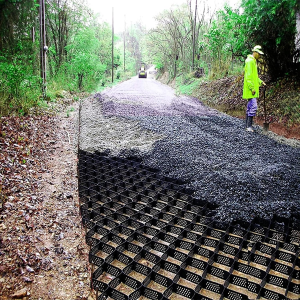What stakes we did use were just 10-12” landscape spikes, to somewhat tack in place as we dumped/spread stone into it. It’s a bit of a balance to find the right amount of stretch and keeping those cavities open. We used manpower more than stakes for stretching/holding while filling, but I would say it could be done single handed, just using more stakes at that point. We would actually pull many of our spikes after stone was in place - mesh wasn’t going anywhere after compacting stone into it/over it, and then pavers on top.
We used a few different depths of mesh as well. Normal for us was a 4”, but also came in a 6” and possibly deeper.
Yes, lightweight and manageable in that sense for one person. I’d guess our pieces weighted 50 pounds and would cover 300 sq ft or so.



